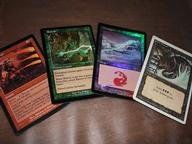Quiz Answer Key and Fun Facts
1. Let's start off easy. What is the maximum hand size at the end of your turn?
2. What is converted mana cost?
3. What is the standard starting life total?
4. Name one of the five basic land types.
5. During combat, who decides which creatures block the attacking creatures?
6. As Magic has grown, new terms have been created for old abilities. Which of the following is not a proper match-up (New - Old)?
7. If you have an instant that says "counter target creature spell" (like "Remove Soul"), when can you use it?
8. What is your Library?
9. Which of the following statements is false?
10. What does the ability "Regenerate" allow you to do?
11. An ability that quite a few creatures in Magic share is First Strike. In the case of a battle between a Deft Duelist, a 2/1 with First Strike, and a Bloodbraid Elf, a 3/2, what would the outcome be?
12. There has been an effect in Magic since its conception: Summoning Sickness. Creatures that are first put into play (or put onto the battlefield) have Summoning Sickness which prevents that from being able to tap and attack that turn (you cannot attack with a creature the turn it is put into play). During your opponent's next turn, can you block using a creature with Summoning Sickness?
13. When are you allowed to play a sorcery?
14. Some older Magic cards had abilities that involved "removing cards from the game". Newer cards have the same ability under which new term?
15. There are quite a few numbers when playing Magic, and sometimes things can get pretty complex. Faerie Swarm is a blue creature whose power and toughness are both equal to the number of blue permanents you control. If you have ten basic islands, three blue creatures (including Faerie Swarm) and two blue enchantments in play and have already played a blue spell in the same turn, what would Faerie Swarm's power and toughness be?
Source: Author
qrayx
This quiz was reviewed by FunTrivia editor
WesleyCrusher before going online.
Any errors found in FunTrivia content are routinely corrected through our feedback system.

